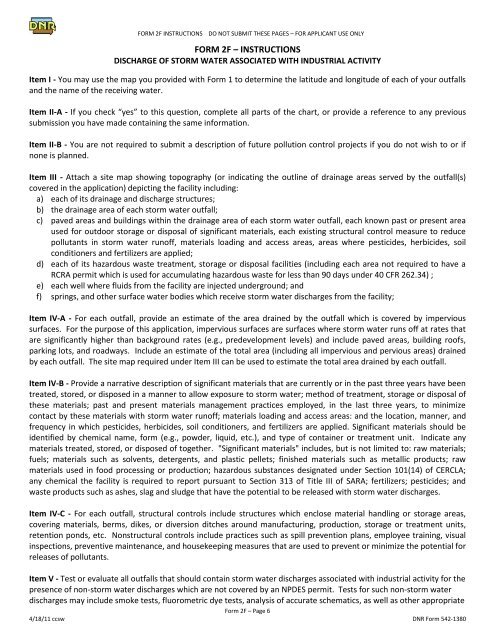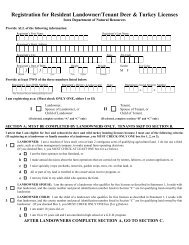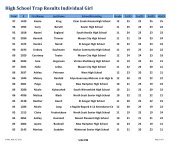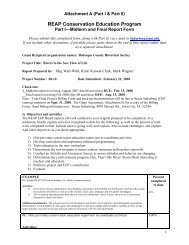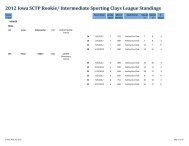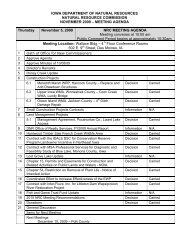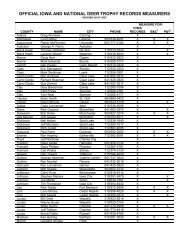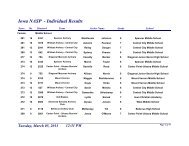iowa department of natural resources npdes permit application
iowa department of natural resources npdes permit application
iowa department of natural resources npdes permit application
You also want an ePaper? Increase the reach of your titles
YUMPU automatically turns print PDFs into web optimized ePapers that Google loves.
FORM 2F INSTRUCTIONS DO NOT SUBMIT THESE PAGES – FOR APPLICANT USE ONLY<br />
FORM 2F – INSTRUCTIONS<br />
DISCHARGE OF STORM WATER ASSOCIATED WITH INDUSTRIAL ACTIVITY<br />
Item I - You may use the map you provided with Form 1 to determine the latitude and longitude <strong>of</strong> each <strong>of</strong> your outfalls<br />
and the name <strong>of</strong> the receiving water.<br />
Item II-A - If you check “yes” to this question, complete all parts <strong>of</strong> the chart, or provide a reference to any previous<br />
submission you have made containing the same information.<br />
Item II-B - You are not required to submit a description <strong>of</strong> future pollution control projects if you do not wish to or if<br />
none is planned.<br />
Item III - Attach a site map showing topography (or indicating the outline <strong>of</strong> drainage areas served by the outfall(s)<br />
covered in the <strong>application</strong>) depicting the facility including:<br />
a) each <strong>of</strong> its drainage and discharge structures;<br />
b) the drainage area <strong>of</strong> each storm water outfall;<br />
c) paved areas and buildings within the drainage area <strong>of</strong> each storm water outfall, each known past or present area<br />
used for outdoor storage or disposal <strong>of</strong> significant materials, each existing structural control measure to reduce<br />
pollutants in storm water run<strong>of</strong>f, materials loading and access areas, areas where pesticides, herbicides, soil<br />
conditioners and fertilizers are applied;<br />
d) each <strong>of</strong> its hazardous waste treatment, storage or disposal facilities (including each area not required to have a<br />
RCRA <strong>permit</strong> which is used for accumulating hazardous waste for less than 90 days under 40 CFR 262.34) ;<br />
e) each well where fluids from the facility are injected underground; and<br />
f) springs, and other surface water bodies which receive storm water discharges from the facility;<br />
Item IV-A - For each outfall, provide an estimate <strong>of</strong> the area drained by the outfall which is covered by impervious<br />
surfaces. For the purpose <strong>of</strong> this <strong>application</strong>, impervious surfaces are surfaces where storm water runs <strong>of</strong>f at rates that<br />
are significantly higher than background rates (e.g., predevelopment levels) and include paved areas, building ro<strong>of</strong>s,<br />
parking lots, and roadways. Include an estimate <strong>of</strong> the total area (including all impervious and pervious areas) drained<br />
by each outfall. The site map required under Item III can be used to estimate the total area drained by each outfall.<br />
Item IV-B - Provide a narrative description <strong>of</strong> significant materials that are currently or in the past three years have been<br />
treated, stored, or disposed in a manner to allow exposure to storm water; method <strong>of</strong> treatment, storage or disposal <strong>of</strong><br />
these materials; past and present materials management practices employed, in the last three years, to minimize<br />
contact by these materials with storm water run<strong>of</strong>f; materials loading and access areas: and the location, manner, and<br />
frequency in which pesticides, herbicides, soil conditioners, and fertilizers are applied. Significant materials should be<br />
identified by chemical name, form (e.g., powder, liquid, etc.), and type <strong>of</strong> container or treatment unit. Indicate any<br />
materials treated, stored, or disposed <strong>of</strong> together. "Significant materials" includes, but is not limited to: raw materials;<br />
fuels; materials such as solvents, detergents, and plastic pellets; finished materials such as metallic products; raw<br />
materials used in food processing or production; hazardous substances designated under Section 101(14) <strong>of</strong> CERCLA;<br />
any chemical the facility is required to report pursuant to Section 313 <strong>of</strong> Title III <strong>of</strong> SARA; fertilizers; pesticides; and<br />
waste products such as ashes, slag and sludge that have the potential to be released with storm water discharges.<br />
Item IV-C - For each outfall, structural controls include structures which enclose material handling or storage areas,<br />
covering materials, berms, dikes, or diversion ditches around manufacturing, production, storage or treatment units,<br />
retention ponds, etc. Nonstructural controls include practices such as spill prevention plans, employee training, visual<br />
inspections, preventive maintenance, and housekeeping measures that are used to prevent or minimize the potential for<br />
releases <strong>of</strong> pollutants.<br />
Item V - Test or evaluate all outfalls that should contain storm water discharges associated with industrial activity for the<br />
presence <strong>of</strong> non-storm water discharges which are not covered by an NPDES <strong>permit</strong>. Tests for such non-storm water<br />
discharges may include smoke tests, fluorometric dye tests, analysis <strong>of</strong> accurate schematics, as well as other appropriate<br />
Form 2F – Page 6<br />
4/18/11 ccsw DNR Form 542-1380


